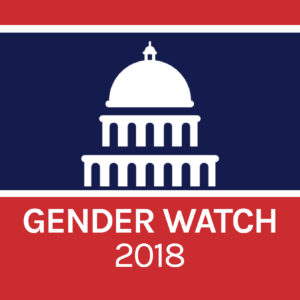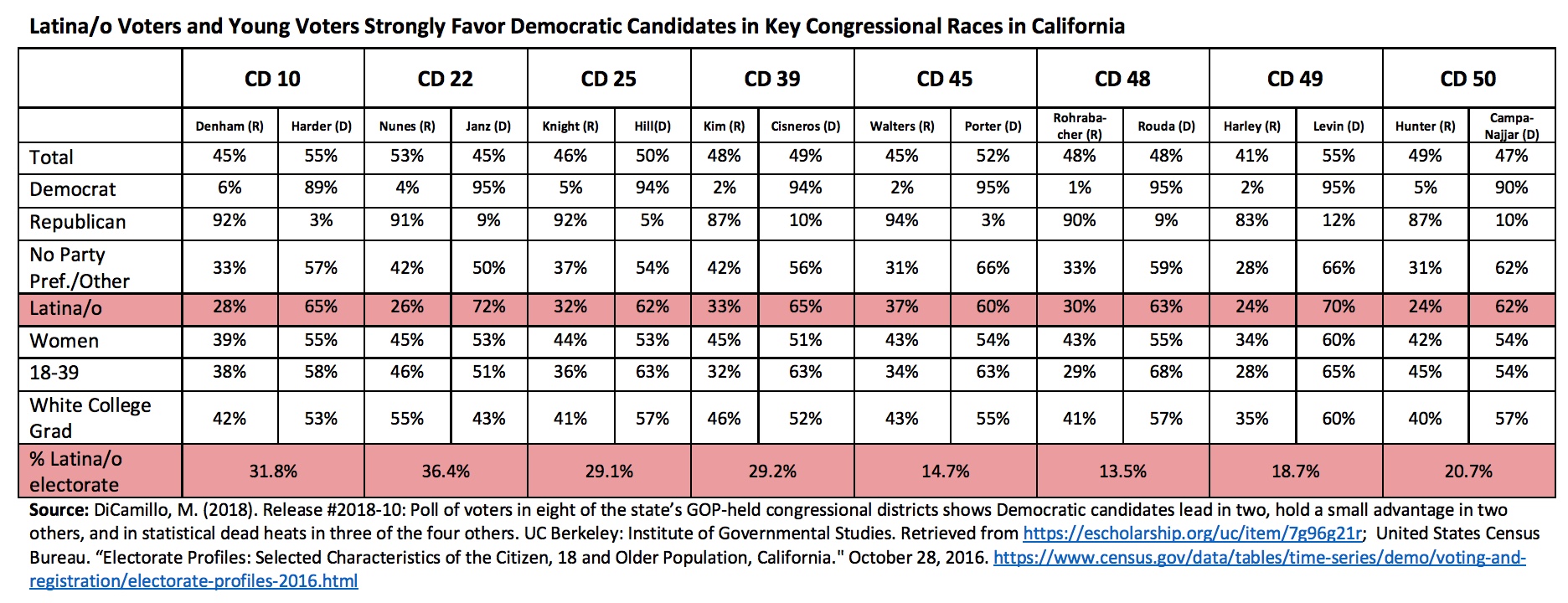Counting on the Latina/o Vote in the 2018 Midterms
 From March to December 2018, the Barbara Lee Family Foundation (BLFF) and the Center for American Women and Politics (CAWP) partnered to offer Gender Watch 2018, which tracked, analyzed, and illuminated gender dynamics in the 2018 midterm elections. With the help of expert scholars and practitioners, Gender Watch 2018 furthered public understanding of how gender influences candidate strategy, voter engagement and expectations, media coverage, and electoral outcomes in campaigns. The blog below was written for Gender Watch 2018, as part of our collective effort to raise questions, suggest answers, and complicate popular discussions about gender’s role U.S. elections.
From March to December 2018, the Barbara Lee Family Foundation (BLFF) and the Center for American Women and Politics (CAWP) partnered to offer Gender Watch 2018, which tracked, analyzed, and illuminated gender dynamics in the 2018 midterm elections. With the help of expert scholars and practitioners, Gender Watch 2018 furthered public understanding of how gender influences candidate strategy, voter engagement and expectations, media coverage, and electoral outcomes in campaigns. The blog below was written for Gender Watch 2018, as part of our collective effort to raise questions, suggest answers, and complicate popular discussions about gender’s role U.S. elections.
In many ways the campaign to fill the open position in Arizona’s 2nd Congressional District seat captures the contours of Latina candidates and voters this election season more than any other race. Like much of the Southwest, this is a district that has seen significant demographic shifts, particularly through immigration and aging of an established White population, resulting in a sizable but not always politically mobilized Latinas/os electorate and a politically dominant conservative White population. Owing in part to its changing demographic, it is also a district where voters have alternated between electing Democratic and Republican representatives and where Hilary Clinton won in 2016, despite the state’s popular votes, and ultimately 11 electoral votes, going to Trump.
In 2018 it is also a district that yielded a diverse field of candidates in the primary season, including two Latinas – Democrat Mary Sally Matiella and Republican Lea Marquez Peterson. While neither had prior political experience, Marquez Peterson bested a field of challengers in an open race to become the Republican nominee, while Mary Sally Matiella lost to Ann Kirkpatrick, a former Congressional representative and Arizona state legislator. Heading into the final weeks of the election, Marquez Peterson trails Kirkpatrick in the polls and a combination of lackluster fundraising, scant support from the Republican National Committee, and Marquez’s own moderate position among a deeply conservative party means that Democrats are likely to regain control of the seat. In the end, despite the fact that two high profile Latinas competed in the district, it is doubtful that either will win the seat.
However, Latinas and Latinos could still prove central to the outcome of Arizona’s 2nd congressional district election, as well as more than two dozen House races around the country, as voters. In Arizona’s 2nd congressional district, polling from the New York Times and Sienna College suggests support for Democratic Ann Kirkpatrick is concentrated among non-white voters (59% v. 37%), women (54% v. 35%), White college graduates (55% v. 38%) and voters with a post graduate education (60% v. 29%). In a district where the Latina/o voting electorate comprises more than 21% of the vote, mobilization of this key constituency, particularly for the Democratic challenger, is essential.
For Democrats looking to pick-up 23 seats currently held by Republicans (and regain control of the House), winning in California is equally important. In California eight seats currently held by white male Republican representatives are considered competitive as incumbents face a growing tide of opposition to Trump and specifically to the current administration’s efforts to curtail the Affordable Care Act and further restrict on immigration. In addition, four of the eight competitive California seats held by Republicans are in districts that Hillary Clinton carried in 2016. In this political environment, Republicans are struggling to mobilize and retain their base while Democrats look to build coalitions of Latinas/os, women, younger, independent/no-party affiliation, college educated, along with party faithful voters to win. Recent polling by the UC Berkeley Institute of Governmental Studies in each of the eight districts suggests that Latina/o and young voters strongly favor Democratic candidates over Republican incumbents. Moreover, the percentage of the Latina/o vote in each district far exceeds the gap between candidates which means an enthusiastic and mobilized Latina/o electorate could determine the outcome of each race.

To reach both Latina/o and young voters, candidates and campaigns need to make serious financial investments in outreach and mobilization. The Democratic Congressional Campaign Committee led by two Latinos- Chairman Ben Ray Lujan and executive director Dan Sena – has made an investment of $25 million into outreach and mobilization of non-traditional and low frequency voters including Latinas/os. Unfortunately, in many of the races in California, Florida, and Texas such investments haven’t reached the Latina/o electorate as more than half report having received no contact from a candidate, campaign, or political party this election cycle. According to a weekly tracking poll by Latino Decisions/NALEO, 54% of Latinos and 64% of Latinas said they had received no contact to either register or vote, this includes door knocking, phone calls, mailers, email, text, or other contact.
Latina/o voters in several districts are also registering less enthusiasm for voting this election. According to an analysis by Politico of over 20,000 interviews conducted with competitive districts voters by Siena College and the New York Times, Latinas/os report being less likely to vote this midterm than either white or black voters. In other words, despite the dozens of Spanish-language TV and radio ads on districts across the country and the hiring of Latina/o field directors in 29 House districts by the DCCC, less than half the Latina/o electorate in key races in CA, FL, and Texas report contact and only about 55% say they are “almost certain” to vote this election. As other Latina political scientists have pointed out, key to addressing the enthusiasm gap for Latinas/os is delivering a mobilizing narrative of value (not merely anger or threat from the Trump administration) with a comprehensive strategy of in-person conversations led by staff whose experience and demographic profile mirror the targeted voters. Moreover, these conversations need to be developed over more than simply one month prior to the election and aimed at incorporating Latinas and Latinos in the entire party structure, not just getting out the vote for one election.
Ultimately, while much of the media attention this year has focused on the increased diversity among candidates and eagerly proclaimed this the “year of the woman,” such proclamations have proven premature if not misplaced when it comes to Latinas. Across the political spectrum this year, 51 Latinas were major party candidates for the U.S. House, while only 1 Latina ran for a seat in the U.S. Senate. In addition, there were only eleven Latinas candidates in the hundreds of statewide contests for governor, lieutenant governor, secretary of state or attorney general across all 50 states. Among Latinas who have won this year, the most consistent quality is experience; over 60% of Latina primary winners are either incumbents, current public officials, or have previous experience as political professionals that make them high-quality candidates with an increased likelihood of success.
Much like the experiences of Mary Sally Matiella and Lea Marquez Peterson in Arizona’s 2nd congressional district, the current political environment has drawn increased participation particularly from women and non-white candidates; however, the long-standing marginalization of such women from the major political parties and fundraising structures won’t be corrected in a single election cycle. And yet, while this year may not be a watershed moment for Latina candidates, Latina/o voters in competitive districts across the country could prove to be the deciding factor that changes the balance of power, particularly in the House.

